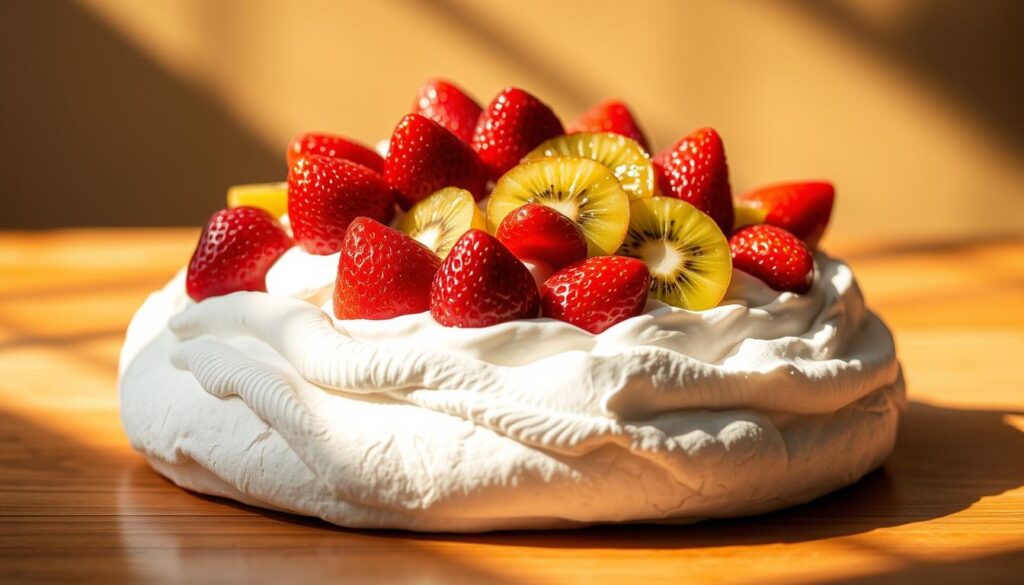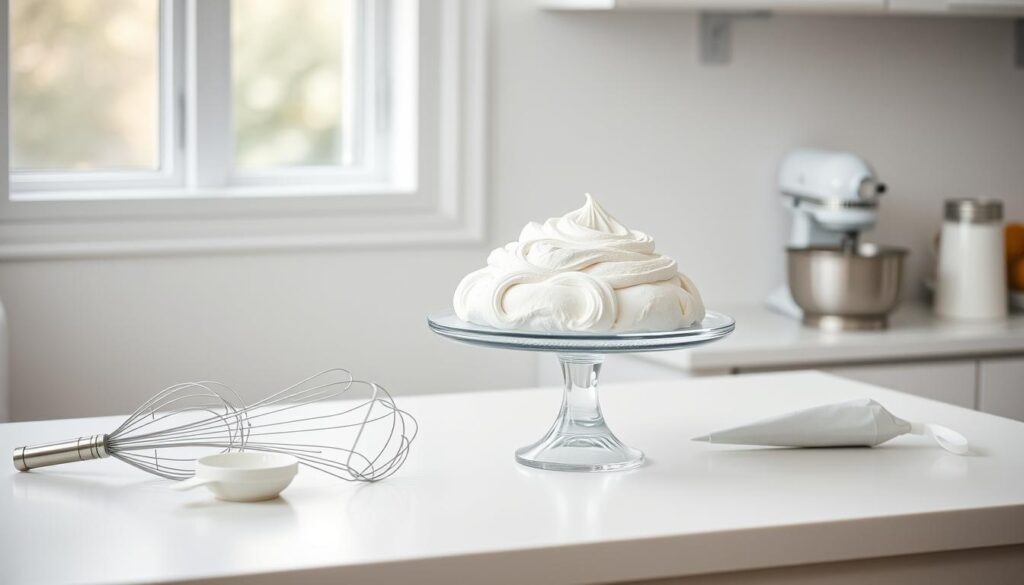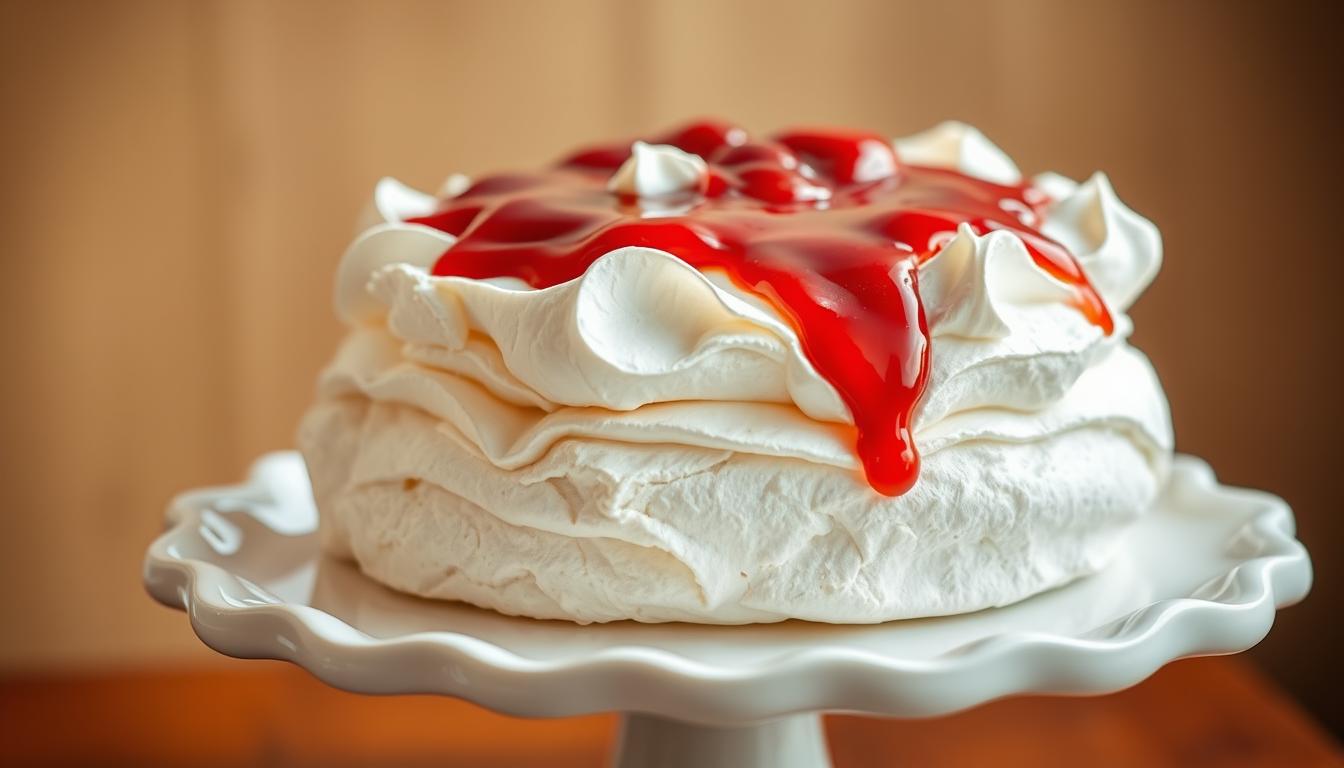I remember my first pavlova experience vividly. It’s a classic Australian dessert with a meringue base, whipped cream, and fresh fruit. It was love at first bite. I knew I had to learn how to make it.
After trying many recipes, I found the perfect one. I’ll share it with you. Plus, I’ll give you tips for a crispy, golden meringue.
Key Takeaways
- A classic pavlova recipe consists of a meringue base topped with whipped cream and fresh fruit.
- To make a perfect pavlova, you need to use fresh ingredients and follow the recipe carefully.
- The meringue base is the foundation of a good pavlova, and it requires precise temperature and cooking time to achieve the perfect texture.
- Whipped cream and fresh fruit add a nice touch to the pavlova, but they should be added just before serving to prevent sogginess.
- With a little practice and patience, you can create a stunning pavlova that will impress your friends and family.
- Pavlova is a popular Australian dessert that is perfect for special occasions and gatherings.
- Meringue is a crucial component of pavlova, and it requires careful preparation to achieve the perfect crispiness.
The Magic of a Perfect Pavlova
Exploring pavlova’s history is fascinating. This classic Australian dessert has been loved for decades. Its crispy meringue and soft center are perfect together.
The first mention of pavlova was in 1926, in an Australian article. Since then, it’s become a favorite globally. It’s easy to make and loved by many.
So, what makes a pavlova perfect? It’s all about the right ingredients and techniques. A good pavlova recipe uses egg whites, sugar, and cornstarch. These are whipped into a stiff, glossy meringue.

Next, we’ll talk about the tools you need for a perfect pavlova. From the right baking sheet to the perfect oven temperature. With the right tools and techniques, anyone can make a stunning pavlova.
Essential Equipment for Pavlova Success
To make a perfect pavlova, you’ll need the right tools. You’ll need a mixing bowl, whisk, and baking sheet. The quality of your pavlova equipment is key to a great dessert. For example, a stainless steel or glass bowl is best for whipping egg whites. They can be chilled in the fridge before use.
A stand mixer or hand mixer with a whisk is crucial for whipping egg whites and sugar. This creates a stable meringue. For baking, a flat baking sheet lined with parchment paper is vital. It helps achieve the perfect shape and texture.

For decorating, consider a pastry bag and tip. They’re great for adding whipped cream and fresh fruit to your pavlova. With the right tools and practice, you’ll make a pavlova that will wow everyone.
Don’t forget a measuring cup, electric scale, and spatula. They’re essential for making your pavlova. Having all the right pavlova equipment lets you focus on making the perfect meringue and whipped cream topping.
Ingredients for Your Signature Pavlova
To make a delicious pavlova, you’ll need the right pavlova ingredients. The base of a great pavlova is its meringue. It needs egg whites, sugar, and cream of tartar. The right sugar to egg whites ratio is key for a crispy meringue.
The pavlova’s topping is just as important. It’s made of whipped cream and fresh fruit. For the whipped cream, you’ll need heavy cream, sugar, and vanilla extract. You can top it with strawberries, blueberries, or kiwis.
- 6 egg whites
- 1½ cups caster sugar
- ¼ tsp cream of tartar
- 300 ml heavy cream
- 2 tbsp sugar
- Fresh fruit or crushed Peppermint Crisp for topping
Make sure your egg whites are at room temperature for better whipping. Also, avoid making pavlovas on humid days to prevent weeping. With these pavlova ingredients and tips, you’ll make a delicious and impressive dessert.
Preparing Your Kitchen for Pavlova Making
To make a great pavlova, your kitchen needs to be ready. A clean, dry space is key. Any moisture or dirt can ruin your meringue. So, clean your countertops, sink, and stove before you start.
Make sure you have everything you need close by. This includes egg whites, sugar, and whipped cream. A tidy kitchen helps you stay focused and avoid mistakes. Remember to take your egg whites out of the fridge and let them sit at room temperature for at least 30 minutes before using them.
Here are some tips to help you prepare your kitchen for pavlova making:
- Clear your countertops of any clutter or obstacles
- Wash and dry your equipment, including your mixing bowls and utensils
- Have all your ingredients measured and ready to use
- Make sure your oven is preheated to the correct temperature
By following these simple steps, you’ll be well on your way to creating a delicious pavlova. You’ll have a perfectly cooked meringue and a dollop of whipped cream. Happy baking!
Creating the Perfect Meringue Base
To make a perfect pavlova meringue, using top-quality egg whites and sugar is key. The right amount of egg whites can be between 100 to 180 ml. For a standard pavlova, about 150 ml of egg whites, or 4-5 eggs, is best.
Beating egg whites to perfection is crucial. Use a mixer or whisk to add air and increase volume. Adding sugar at the right moment is also vital. It helps stabilize the meringue and gives it a smooth, glossy look. Use 1 cup of caster sugar, adding it slowly while beating.
To get the perfect texture, the meringue should be crisp outside and soft inside. Bake it at 100°C for 1 hour and 30 minutes. Let it cool completely, ideally overnight or for 18 hours.
- Use room-temperature egg whites for better stability
- Add sugar gradually to prevent deflation
- Use a low oven temperature to prevent cracking
- Don’t open the oven door during the baking time
By following these tips and using the right egg whites and sugar, you’ll make a perfect pavlova meringue. It will impress your friends and family.
Baking and Cooling Your Pavlova
When baking a pavlova, temperature and time are key. Preheat your oven to 130°C. Then, after 10 minutes, lower it to 90°C. This slow change prevents cracks.
The baking time is about 90 minutes. After, let it cool slowly in the oven. This ensures it cools evenly.
It’s important to avoid sudden temperature changes when cooling. Let your pavlova cool completely in the oven. This prevents cracking and keeps the meringue stable.
To check if it’s ready, rub a small part of the meringue between your fingers. If it feels smooth, the sugar has dissolved.
Here are some tips for pavlova baking and cooling:
- Bake at a low temperature to prevent the meringue from browning too quickly.
- Reduce the oven temperature after the initial baking period to promote even cooking.
- Allow the pavlova to cool slowly in the oven to prevent cracking.
- Use a food processor or blender to pulse the sugar a few times, ensuring it’s well incorporated into the egg whites.
By following these guidelines and taking your time, you’ll get a delicious, crispy meringue base. And a beautiful, crack-free dessert. Remember, patience is key. So, don’t rush the process, and you’ll enjoy a perfect pavlova every time.
Whipped Cream and Topping Techniques
To make a perfect pavlova, mastering whipped cream and toppings is key. I use cream and sugar to stabilize whipped cream. My recipe includes 1 1/2 cups of heavy cream, 4 1/2 tablespoons of confectioners’ sugar, and 1 teaspoon of gelatin.
I enjoy topping my pavlova with seasonal fruit. Favorites include fresh berries, mango, and kiwi. The whipped cream and fruit mix is sweet and tart, offering a great taste. Adding powdered sugar or fresh mint leaves adds a special touch.
- Use cold cream and equipment for best results.
- Whip cream for 2 to 3 minutes for soft peaks.
- Add sugar and gelatin after whipping.
- Choose seasonal fruit for topping.
- Be creative with garnishes for a personal touch.
Follow these tips and use the right ingredients for a stunning pavlova. Enjoy experimenting with flavors and toppings to make it unique.
Troubleshooting Common Pavlova Problems
When baking pavlova, I’ve run into some common issues. Cracking is a big one, often due to wrong baking or cooling. To fix this, bake at 200 to 250 degrees Fahrenheit. Then, cool it slowly in the oven to avoid sudden drops in temperature.
Sinking is another problem, usually from baking too little or too much. To solve this, bake for 1 to 2 hours, depending on the size.
Here are some tips to help with pavlova problems:
- Use stainless steel or glass bowls to avoid moisture and grease.
- Whip egg whites for 8 to 10 minutes until stiff and stable.
- Add sugar slowly, one tablespoon at a time, to prevent weeping.
- Shape the meringue into a round, 1 inch tall, for even baking.
By following these tips, you can make a stunning pavlova. Troubleshooting is all about finding the problem and fixing it. Don’t be afraid to try new things. With practice, you’ll master pavlova and your meringue will shine.
Conclusion: Serving and Enjoying Your Homemade Pavlova
Now that you’ve mastered the art of creating a perfect pavlova, it’s time to present and enjoy your delectable creation. Place the pavlova on a beautiful serving platter. Top it with a generous dollop of freshly whipped cream and an array of vibrant, seasonal fruits. Raspberries, kiwi, mango, and passionfruit make for a stunning and flavorful combination.
As you slice into the pavlova, savor the contrast between the crisp, delicate meringue exterior and the soft, pillowy interior. The sweet, luscious whipped cream perfectly complements the tangy fruit toppings. This creates a harmonious balance of flavors and textures. Indulge in each bite, savoring the homemade goodness that you’ve poured your heart into creating.
Pavlova is a dessert that brings people together, so don’t be afraid to share your masterpiece with friends and family. Gather around the table, pour a cup of tea or coffee, and enjoy the simple pleasure of homemade pavlova. It’s a delightful way to conclude any meal or celebration, leaving your guests in awe of your baking prowess and the irresistible sweetness of this iconic dessert.
Table of Contents
FAQ
What is pavlova?
Pavlova is a classic Australian dessert. It has a meringue base, topped with whipped cream and fresh fruit.
What is the history of pavlova?
Pavlova started in the early 20th century. It’s loved for its unique texture and flavor.
What equipment is needed to make pavlova?
You’ll need a mixing bowl, whisk, and baking sheet to make pavlova.
What ingredients are used to make pavlova?
To make pavlova, you need egg whites, sugar, and cream of tartar.
How should the kitchen be prepared for making pavlova?
Make sure your kitchen is clean and dry. This helps pavlova turn out best.
How do you create the perfect meringue base for pavlova?
Beat the egg whites until perfect. Add sugar at the right time for the best meringue.
How do you bake and cool pavlova properly?
Bake pavlova at a low temperature. Cool it slowly to avoid cracking.
How do you make stabilized whipped cream and top the pavlova?
Use cream and sugar to make whipped cream. Top the pavlova with fruit and creative garnishes.
What are the common problems with pavlova and how can they be troubleshooted?
Cracking and sinking are common issues. Follow the recipe and use troubleshooting tips to avoid them.
How should homemade pavlova be served and enjoyed?
Serve pavlova beautifully. Offer a variety of toppings for a great experience.
SEE MORE : Easy banana cake recipe


